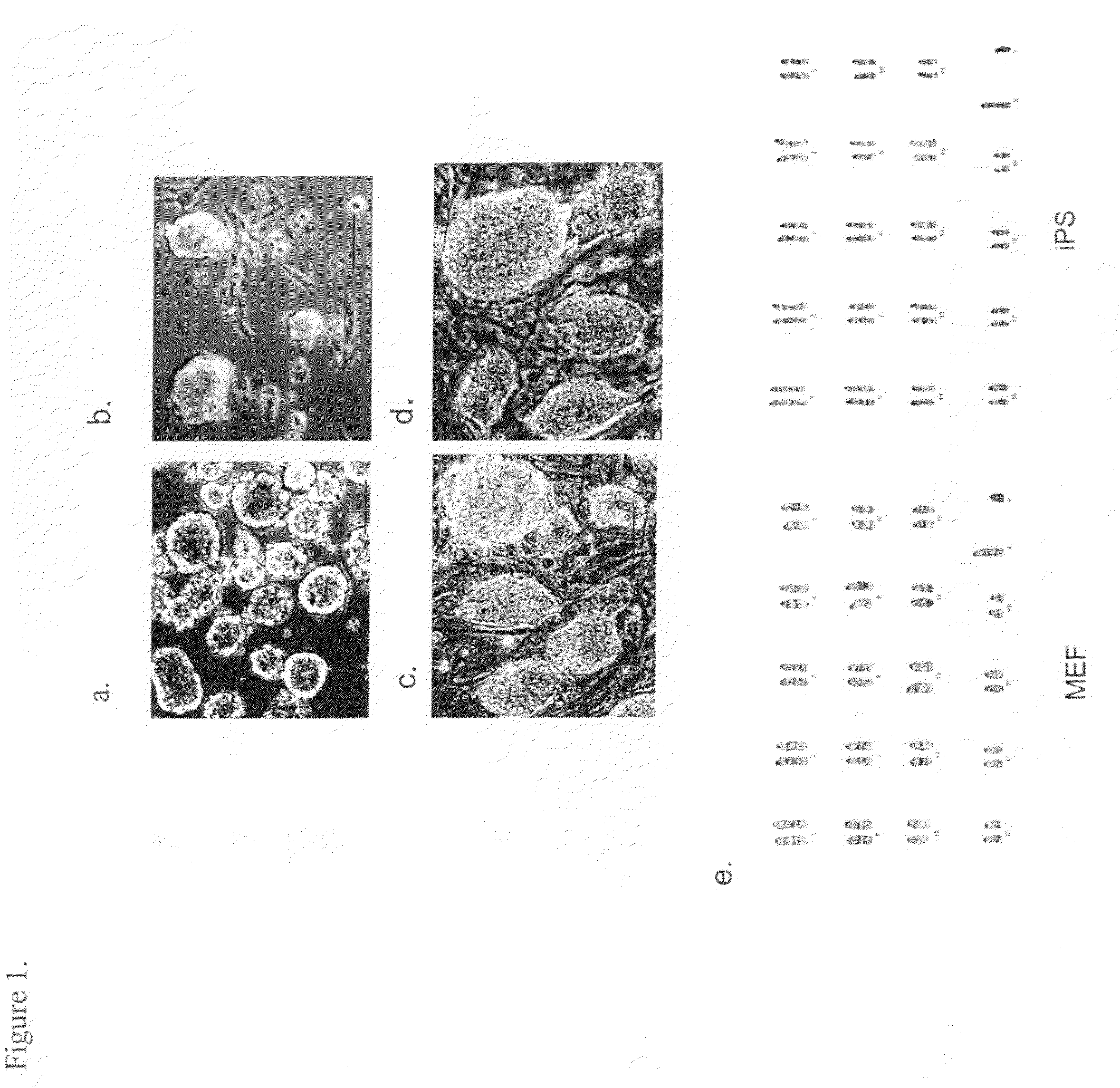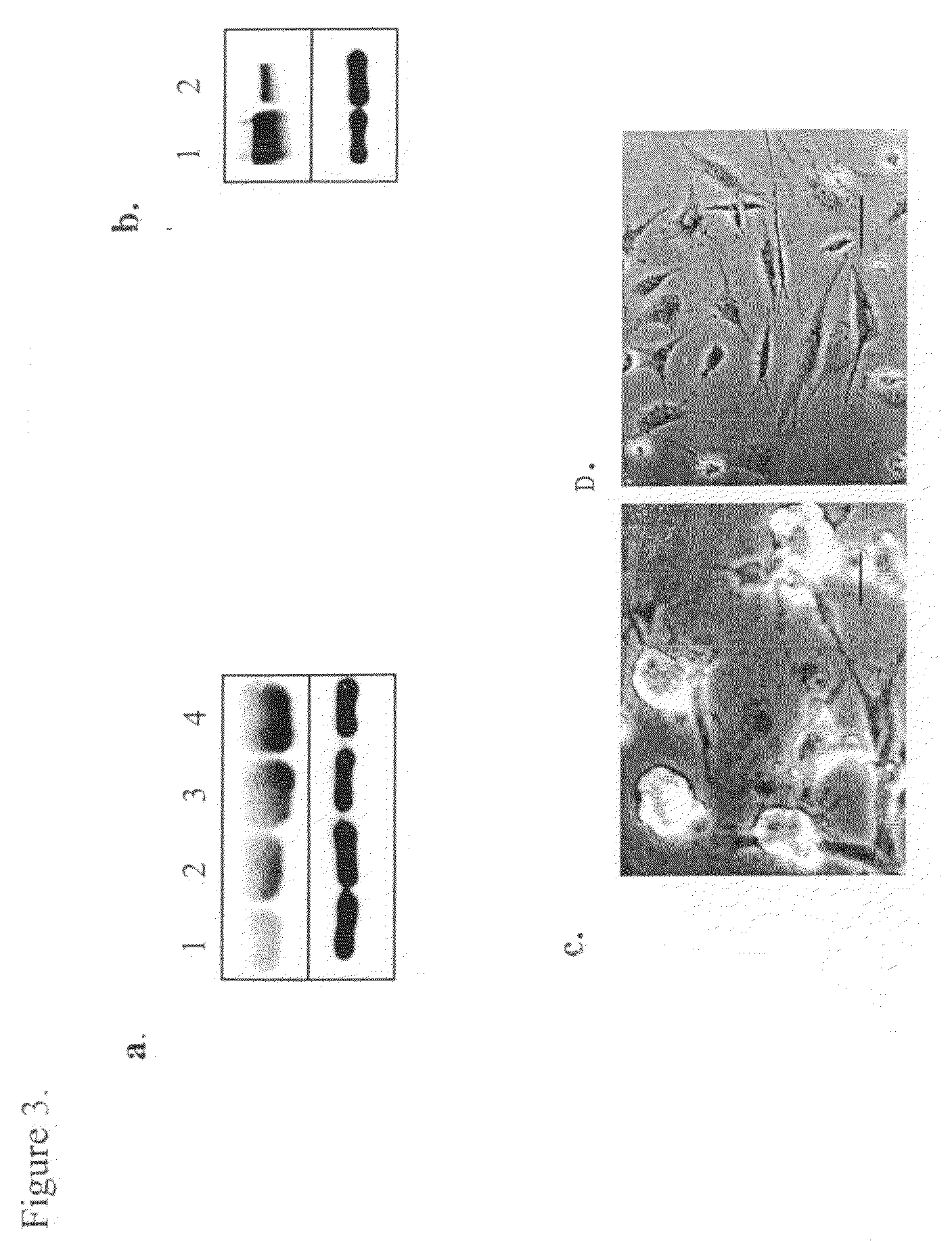Methods of producing pluripotent stem-like cells
- Summary
- Abstract
- Description
- Claims
- Application Information
AI Technical Summary
Benefits of technology
Problems solved by technology
Method used
Image
Examples
example 1
SR-Containing Serum Free Medium Promoted Dedifferentiation of Skin Fibroblast Cells into Stem Cell-Like Cells
[0134]To investigate the possibility that serum replacement (SR)-containing medium can promote the reprogramming and dedifferentiation of skin fibroblast cells into pluripotent stem-like cells, mouse skin fibroblast cells were cultured in fibroblast growth medium, and were then transferred by trypsinization to plates holding SR-containing medium. Within a few hours, the SR-containing medium caused the majority of the transferred cells to become rounded in shape. Twenty-four hours post-transfer, a majority of cells became small, round, bright-edged granulated cells (FIG. 1a). At three days post-transfer, some of the granulated cells grew into large, stem cell-like colonies and attached to the bottom of the plates (FIG. 1b). These ES-like cells could be picked or passaged as a whole plate in SR-containing medium for an additional 5 or more passages, allowing for establishment o...
example 2
Lipid-Rich BSA in the SR Medium was Essential for Reprogramming Fibroblasts into Stem Cell-Like Cells
[0135]SR-containing ES media consisted of a combination of basal media containing DMEM / F12, 1× non-Essential Amino Acids, 1× L-Glutamine, 0.1 μM β-mercaptoethanol and 20% Serum Replacer (SR). To further examine whether SR was the key component responsible for promoting the reprogramming of skin fibroblasts into ES-like cells, skin fibroblast cells were transferred by trypsinization to basal medium with or without SR. Results of these experiments demonstrated that SR was the critical component for promoting reprogramming of fibroblast cells into ES-like cells (FIG. 2a).
[0136]The formulation of SR that was present in serum-free medium comprised ingredients such as thiamine, reduced glutathiones, ascorbic acid-2-PO4, transferrin, insulin, and lipid-rich BSA (AlbuMax I, Invitrogen; Costagliola and Agrosi. Curr. Med. Res. Opin. 21:1235). To identify the component(s) of SR that possessed t...
example 3
SR Induced Fibroblast Cell Reprogramming by Increasing Ca2+ Influx, Increasing Fibroblast Growth Factor Receptor 3 Expression and Causing Demethylation of the Oct4 Promoter
[0137]Following transfer of fibroblast cells into SR-containing stem cell medium, stronger Ca2+ signalling and up-regulation of the expression of fibroblast growth factor receptor 3 (FGFR3) was observed to occur in a time-dependent manner (FIGS. 3a &3b). (Up-regulation of FGFR3 had been previously shown to play an important role in the reprogramming of primordial germ cells into stem-like cells (Skottman et al. Stem Cell 24:151-167).)
[0138]In view of the observed involvement of the FGF signaling pathway, it was then examined whether Ca2+ might be an important secondary messenger responsible for regulating the reprogramming of fibroblast cells induced by SR containing medium activation of the FGF signaling pathway. Thapsigargin, a tight-binding inhibitor for sarco / endoplasmic reticulum Ca2+ ATPase, was added to the...
PUM
 Login to View More
Login to View More Abstract
Description
Claims
Application Information
 Login to View More
Login to View More - Generate Ideas
- Intellectual Property
- Life Sciences
- Materials
- Tech Scout
- Unparalleled Data Quality
- Higher Quality Content
- 60% Fewer Hallucinations
Browse by: Latest US Patents, China's latest patents, Technical Efficacy Thesaurus, Application Domain, Technology Topic, Popular Technical Reports.
© 2025 PatSnap. All rights reserved.Legal|Privacy policy|Modern Slavery Act Transparency Statement|Sitemap|About US| Contact US: help@patsnap.com



